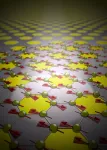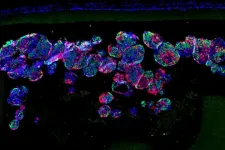Bringing order to hydrogen energy devices
Scientists have found a way to make hydrogen move faster through a solid material at cooler temperatures, paving the way for more sustainable and practical energy storage devices
2021-06-02
(Press-News.org) Researchers at Kyoto University's Institute for Cell-Material Sciences (iCeMS) have developed a new approach to speed up hydrogen atoms moving through a crystal lattice structure at lower temperatures. They reported their findings in the journal Science Advances.
"Improving hydrogen transport in solids could lead to more sustainable sources of energy," says Hiroshi Kageyama of iCeMS who led the study.
Negatively charged hydrogen 'anions' can move very quickly through a solid 'hydride' material, which consists of hydrogen atoms attached to other chemical elements. This system is a promising contender for clean energy, but the fast transport only happens at really high temperatures, above 450°C. Kageyama and his team have figured out how to make hydrogen anions travel even faster through a hydride at much lower temperatures.
"In the past, it was believed that the key to high ionic conductivity at low temperature was to stabilize a material's high temperature phase by introducing chemical disorder," says Kageyama. Scientists do this by adding oxygen-containing compounds called oxides into the structure. Instead, Kageyama and his colleagues introduced an ordered structure into a barium hydride crystal, which caused hydrogen anions to move significantly faster even at 200°C.
"Achieving high ionic conductivity at low temperatures by ordering the anions is unprecedented and may be applicable to various ionic conductors in the future," says Kageyama.
Kageyama and his team changed the structure of a typical barium hydride by introducing layers on either side that are composed of hydrogen attached to another anion. By doing this, they made three different materials, using bromide, chloride or iodide anions. This provided a more ordered structure to the original material, preventing it from changing from the highly stable and symmetrical hexagon-shaped lattice usually found at high temperatures, to a less stable orthorhombic-shaped structure as it cooled. Hydrogen anions moved through the organized lattice very quickly at 200°C. The material even conducted the hydrogen anions at room temperature, albeit at a slower rate.
"Improving hydrogen anion conductivity down to room temperatures could enable low-temperature operation of electrochemical devices, like fuel cells, and open up avenues for their use as industrial catalysts or as solid hydrogen sources for hydrogenation reactions," Kageyama says.
INFORMATION:
DOI: 10.1126/sciadv.abf7883
About Kyoto University's Institute for Integrated Cell-Material Sciences (iCeMS):
At iCeMS, our mission is to explore the secrets of life by creating compounds to control cells, and further down the road to create life-inspired materials.
https://www.icems.kyoto-u.ac.jp/
For more information, contact:
I. Mindy Takamiya
cd@mail2.adm.kyoto-u.ac.jp
[Attachments] See images for this press release:

ELSE PRESS RELEASES FROM THIS DATE:
2021-06-02
Stone tools have been made by humans and their ancestors for millions of years. For archaeologists these rocky remnants - lithic artefacts and flakes - are of key importance. Because of their high preservation potential they are among the most common findings in archaeological excavations. Worldwide, numerical dating of these lithic artefacts, especially when they occur as surface findings, remains a major challenge. Usually, stone tools cannot be dated directly, but only when they are embedded in sediment layers together with, for example, organic material. The age of such organic material can be constrained via the radiocarbon technique. If such datable organic remains are ...
2021-06-02
Tested on human blood in the lab, the selective nanocapsules could reduce the side effects of a major blood clot dissolving drug, which include bleeding on the brain. If confirmed with animal tests, the nanocapsules could also make the drug more effective at lower doses.
Blood clots, also known as thrombi, are a key cause of strokes and heart attacks which are leading causes of death and ill-health worldwide. They can be treated with a clot dissolving drug called tissue plasminogen activator (tPA) which disrupts clots to clear the blocked blood vessel and re-establish blood ...
2021-06-02
Known as nature's own sonar system, echolocation occurs when an animal emits a sound that bounces off objects in the environment, returning echoes that provide information about the surrounding space.
While echolocation is well known in whale or bat species, previous research has also indicated that some blind people may use click-based echolocation to judge spaces and improve their navigation skills.
Equipped with this knowledge, a team of researchers, led by Dr Lore Thaler, of Durham University, UK, delved into the factors that determine how people learn this skill.
Over the course of a 10-week training programme, the team investigated how blindness and age affect learning ...
2021-06-02
Atomically thin van der Waals magnets are widely seen as the ultimately compact media for future magnetic data storage and fast data processing. Controlling the magnetic state of these materials in real-time, however, has proven difficult. But now, an international team of researchers led by Delft University of Technology (TU Delft) has managed to use light in order to change the anisotropy of a van der Waals antiferromagnet on demand, paving the way to new, extremely efficient means of data storage.
The thin atomic layers that make up van der Waals magnets may seem extremely fragile, but they can be about 200 times stronger ...
2021-06-02
In a six-month study of more than 1,000 Americans, R. Kelly Garrett and Robert Bond found that U.S. conservatives were less able to distinguish truth from falsehoods in 20 viral political news stories that appeared online between January and July 2019. Differences in the political orientation of these stories may help explain this observation, the researchers note, writing that "we find that high-profile true political claims tend to promote issues and candidates favored by liberals, while falsehoods tend to be better for conservatives." Two-thirds (65%) of the high-profile true stories were characterized as benefiting the political left, compared with only 10% that were described as benefiting the political right. Among high-profile false stories, 45.8% were perceived to benefit the ...
2021-06-02
Individuals at higher risk of developing pancreatic cancer could be identified earlier using machine learning (ML) techniques which would result in a greater number of patients surviving the disease, suggests a new study published in PLOS ONE.
The study was led by the London School of Hygiene & Tropical Medicine (LSHTM) and funded by the UK charity Pancreatic Cancer Research Fund (PCRF).
It used UK electronic health records for more than 1,000 patients aged 15-99 years who were diagnosed with pancreatic cancer between January 2005 and June 2009.
The researchers examined numerous symptoms and ...
2021-06-02
A team of researchers led by diabetes specialists and biomedical engineers at Washington University School of Medicine in St. Louis and Cornell University has demonstrated that, using a miniscule device, they can implant insulin-secreting cells into diabetic mice. Once implanted, the cells secrete insulin in response to blood sugar, reversing diabetes without requiring drugs to suppress the immune system.
The findings are published June 2 in the journal Science Translational Medicine.
"We can take a person's skin or fat cells, make them into stem cells and then grow those stem cells into insulin-secreting cells," said Jeffrey R. Millman, PhD, an associate professor of medicine at Washington ...
2021-06-02
A new study reveals that B cells can produce antibodies against the H1N1 influenza virus that also neutralize various other influenza strains, marking a development that could inform research into potential universal flu vaccines. The findings showed that the antibodies targeted two conserved regions of the virus - the cause of the 2009 swine flu pandemic - and that transfers of the antibodies protected mice from lethal infection. The work suggests that vaccines that target the two sites might be able to protect against a broader array of flu strains. Influenza is one of humanity's greatest microbial ...
2021-06-02
RICHLAND, Wash.--Scientists have created a cybersecurity technology called Shadow Figment that is designed to lure hackers into an artificial world, then stop them from doing damage by feeding them illusory tidbits of success.
The aim is to sequester bad actors by captivating them with an attractive--but imaginary--world.
The technology is aimed at protecting physical targets--infrastructure such as buildings, the electric grid, water and sewage systems, and even pipelines. The technology was developed by scientists at the U.S. Department of Energy's Pacific Northwest National Laboratory.
The starting point for Shadow Figment is an oft-deployed technology called a honeypot--something attractive to lure an attacker, perhaps a desirable target with the appearance of easy access.
But ...
2021-06-02
A new study from North Carolina State University found that certain types of messages could influence how people perceive information about the spread of diseases from wildlife to humans.
The researchers say the findings, published in the journal Frontiers in Communication, could help scientists, policymakers and others more effectively communicate with diverse audiences about zoonotic diseases and the role of wildlife management in preventing them from spreading to people. Zoonotic diseases are diseases that originate in wildlife and become infectious to people.
"If we want to prevent ...
LAST 30 PRESS RELEASES:
[Press-News.org] Bringing order to hydrogen energy devices
Scientists have found a way to make hydrogen move faster through a solid material at cooler temperatures, paving the way for more sustainable and practical energy storage devices



